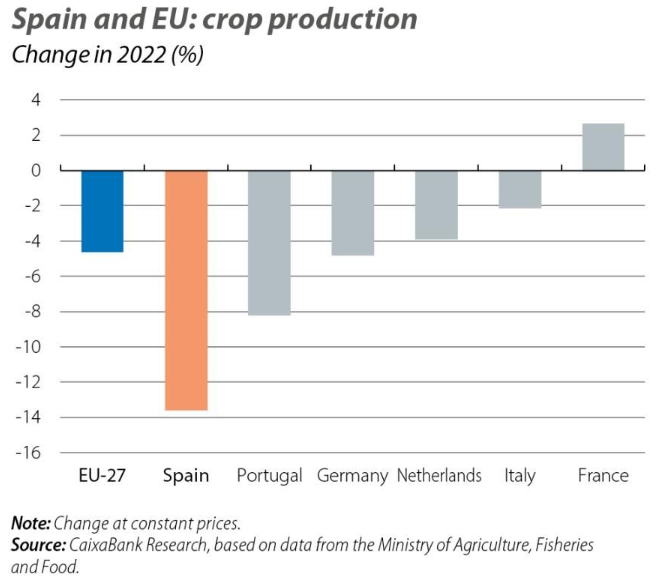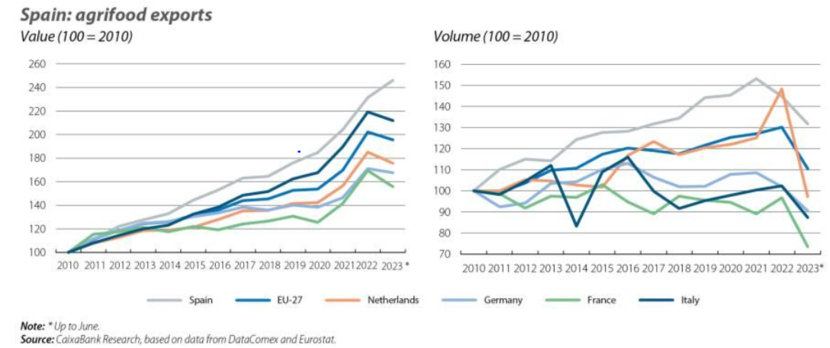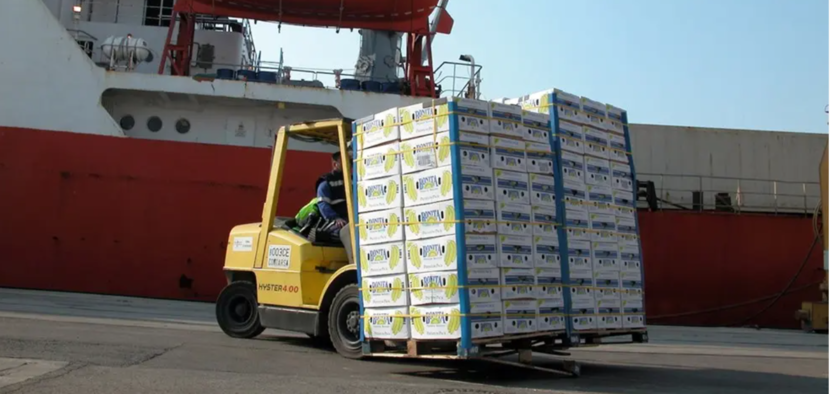Spain: Maintaining the competitiveness of the agri-food sector in the face of adverse conditions
Spain’s agricultural output fell sharply in 2022 and estimates suggest that it has fallen once again in 2023, due to the sharp rise in costs and the effects of climate change. Nevertheless, agri-food exports have evolved relatively well and the sector’s competitiveness indicators do not seem to have suffered too much for the time being.

Despite the effects of the prolonged drought and the sharp rise in production costs, the Spanish agri-food sector is showing a moderate growth trend and has managed to maintain the competitiveness and dynamism of its exports. According to the latest sectoral report from Caixabank Research, Spain’s agri-food sector is making headway in challenging context.
The main facts found in the report are as follows:

1. The Spanish agri-food sector is suffering the effects of the prolonged drought throughout Europe, which has been particularly severe in Spain, as well as the sharp rise in production costs. Both factors had a considerable impact on primary sector production in 2022, down by 8.8% in real terms. On the other hand, it’s important to note that the most adverse scenarios regarding the risk of shortages for Spanish agriculture that were predicted after Russia’s invasion of Ukraine have not actually materialised and agricultural commodity prices have corrected significantly on international markets. This has resulted in better figures in the first half of 2023; a trend of moderate growth that we expect to continue in the coming quarters.
2. The fact that input prices are moderating on international markets (cereals, fertilisers and energy) should help to reduce costs in Spain’s agri-food sector and, ultimately, ease the inflationary pressures on food prices paid by the end consumer. This, together with a gradual recovery in the purchasing power lost by households in recent quarters, will help to boost household demand for food.

3. One current concern is how the rising costs experienced by the sector may affect its competitiveness. Consequently, this report devotes an article to analysing the developments in Spanish agri-food production and exports compared with the other main agri-food players in Europe (France, Italy, Germany and the Netherlands), revealing that Spain has performed relatively well despite experiencing a sharper increase in costs and a longer drought than its peers.
4. The sector needs to continue its transformation in order to overcome the climate challenge, improving its competitiveness and becoming more efficient in the use of productive resources. One important factor is the size of farms, since larger enterprises tend to be more efficient and competitive. Data from the agricultural census show a positive trend in this respect: in the last decade there has been an increase in the number of bigger farms, although the average Spanish farm is still small compared with other European countries more productive than Spain
5. Another relevant aspect to improve farm resilience is the diversification of sources of income. In this respect, rural tourism looks like being a good complementary activity to farming. After the pandemic, rural destinations have been a great alternative destination, leading to higher growth in tourism in the less urban regions of Spain than in its more traditional coastal destinations and cities.

The fall in agricultural production in Spain
In 2022, Spanish crop production recorded a sharp drop in volume (–13.6%), curtailing the upward trend of previous years. Although the decline was widespread across all European crops and countries, Spain registered a bigger drop than the EU as a whole (–4.6%) and also compared with the top 5 European producers (excluding Spain): Germany (–4.8%), France (+2.7%), Italy (–2.1%) and the Netherlands (–3.9%).

Estimates for the 2023 harvest are once again particularly weak for the country, in contrast to a more positive trend for the EU average. Winter grain production is expected to be the hardest hit, with some 9 million tons (Mt) in 2023 (compared to 14.4 Mt in 2022 and 19.3 Mt in 2021). This represents a very significant fall in grain yields (over 30%), in contrast to the better performance in the case of the EU average. Olive oil production also fell significantly from 1,489,351 tons last season to 675,093 tons in 2022-2023, marking a 55% drop in output which drove up the price.
Moderating production costs will help contain food price inflation
The outlook is somewhat more favourable in terms of production costs in the sector, thanks to the sharp decline in agricultural commodity and energy prices in international markets relative to last year’s record levels.

This global drop in prices is beginning to be reflected in the prices paid by farmers in Spain. The costs of agricultural inputs fell by 11.2% between August 2022 (when they peaked) and May 2023 (latest available data), especially energy (–42.3%) and fertilisers (–25.7%). Despite this decline, costs are still around 35% higher than the 2019 average.
However, the fall in the price of livestock feed, which is the biggest single component in the primary sector’s cost structure (54.4% of the total in 2022), is still very limited (–6.6% versus the peak of November 2022). Given that Spain imports around half of the grain destined for animal feed, the decline in international grain prices should help to contain the cost of feeding livestock in the coming months.

The moderation of agricultural input costs should ease inflationary pressures on the food prices paid by end consumers. In August 2023, the food CPI rose 10.1% year-on-year: while still higher than normal, this marks a considerable moderation from the peak of 15.7% registered in February 2023. This, together with the gradual recovery of household purchasing power in recent quarters, ought to boost household demand for food.
The Spanish agri-food sector remains competitive, despite the challenging conditions
One current source of concern is the impact that higher costs could have on the agri-food sector’s competitiveness. However, when we compare the evolution of Spanish agri-food exports with that of other European powers (France, Italy, Germany and the Netherlands) we see that Spain has performed relatively well.

Spanish agri-food exports in terms of value have continued to register strong growth over the last two years, supported by the high prices of most products in international markets. In terms of volume, in contrast, these exports have amassed setbacks of 5.5% in 2022 and 9.1% in 2023 (year-on-year to June), although these declines have been less pronounced than in the major European countries or in the EU as a whole (–15.1%).
Further proof of the strength of Spain’s agri-food sector is its high share of global trade and its relative good evolution over time. Based on data for 2021 (latest available from the WTO), Spain is seventh in the global ranking of exporters and fourth among European countries (behind the Netherlands, Germany and France, but ahead of Italy), accounting for 3.8% of global exports, which is a much higher share than we represent in the total trade of all goods (1.7%).

In addition, since 2010 it has improved its global market share in agri-food exports (+0.3 pps), which is a considerable feat when compared with other powers such as the US (which has seen its market share drop by 0.8 points in the same period), France (–1.2 points) or the Netherlands (–1.1 points). If we focus the analysis on the top 5 European powers, Spanish exports have grown as a portion of the total, going from 10.9% in 2010 to 16.1% in 2023 (with data up to June).
In short, Spain’s agricultural output fell sharply in 2022 and estimates suggest that it has fallen once again in 2023, due to the sharp rise in costs and the effects of climate change, one of the major challenges facing the sector. Nevertheless, despite the fall in production, agri-food exports have evolved relatively well and the sector’s competitiveness indicators do not seem to have suffered too much for the time being.
See the full report in English here: The Spanish agrifood sector is making headwayin a challenging context (caixabankresearch.com)